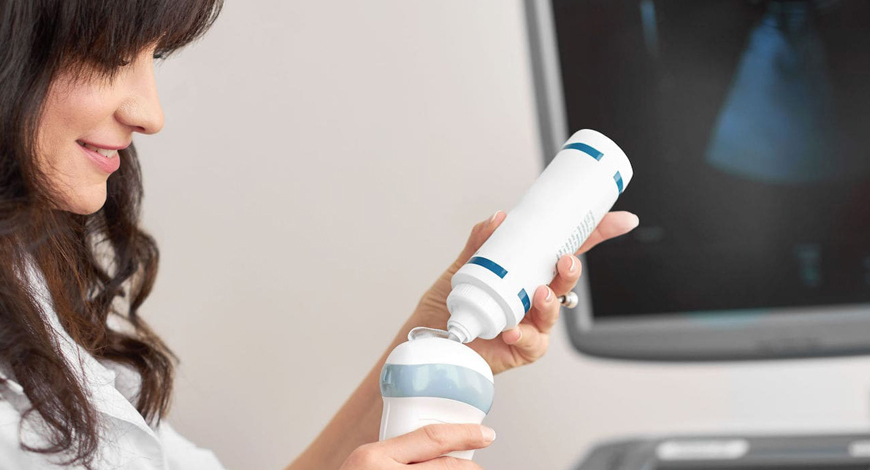MB Stories
Ultrasound outlook looks bright

Recent advances in ultrasound image systems as AI, automation, POCUS and advances of therapeutic systems are making it standard care for many diseases.
Ultrasound is more accessible than ever, its utility extending across the entire continuum of care has become fundamental to providing cost-effective care for patients around the world. Though ultrasound originated within traditional imaging, novel point-of-care applications are now being performed and are contributing to better patient care that is safer and more economical than traditional imaging. Advances like AI and 4D imaging are leading to crispers images and more efficient data collection. Doctors can see more now than ever before. There is a growing body of evidence about the benefits of the point-of-care ultrasound and why it should be standard care for many diseases.
An ultrasound gives clinicians incredible insight into patients’ bodies and allows them to diagnose, intervene, treat, and monitor the condition of patients closely. Even though it was invented around 100 years ago, this is still relatively young technology.
The impact of ultrasound technology has grown as new uses demonstrate their usefulness in a variety of settings.
 Dr Christina George
Dr Christina George
Professor (Anesthesiology & Pain Services),
CMC Hospital
“With the increased use of advanced monitoring, it was but expected that ultrasound would find its well-deserved place in the field of anesthesia. It began with the modest use of ultrasound in lung pathologies for a quick and accurate bedside diagnosis. To distinguish pleural effusions, detect accidental punctures during procedures, differentiate pulmonary edema from ARDS or evaluate a consolidation i.e. pneumonia it surpasses the humble X-rays. But the real need was felt, when ultrasound made difficult intravenous cannulations super easy, be it patients with coagulopathies, distorted neck anatomy or patients in shock needing inotropic support in minutes. Later, USG was tried in chronic pain procedures replacing CT scan with real time visualization of structures thus facilitating neuraxial blocks and nerve root blocks. Most recently, anesthesiologists use ultrasound for peripheral nerve blocks (PNBs) as the local anesthetic can be visualized directly depositing around the nerve. Soon enough, it will become the gold standard for PNBs.”
Recent advances in ultrasound image systems seen over the past year include the integration of artificial intelligence (AI), automation of functions and measurements, introduction of very specialized tool sets, the rapid growth in point-of-care systems, improved ergonomics, and on the horizon, the development of therapeutic ultrasound systems for cardiovascular and cancer therapies.
Point-of-care ultrasound advances. In 2020, many clinicians continued to explore novel uses for ultrasound to address a growing list of critical medical needs. Users have looked to manufacturers for improved image quality and updates to the instrument’s size and capabilities to solve long-standing challenges, eg, user discomfort and complex workflows, requesting product designs that improve mobility, cleanability, and usability.
Handheld and mobile technologies are seeing new, expanded use, with innovation proving especially useful as clinicians include ultrasound in the triage and treatment of patients suffering from COVID-19. There was a big question as to the best imaging modality for detection of COVID-19 and later for monitoring critically ill virus patients in the ICU. CT became a front line imaging modality in most emergency departments and mobile digital radiography (DR) X-ray systems saw a big bump is sales in 2020 to enable imaging in patient rooms or dedicated units in COVID wards. But, the imaging modality to see a virtual explosion in 2020 was small, compact point-of-care ultrasound (POCUS) systems.
These included small cart based systems and handhelds. Handheld systems like the Philips Lumify, GE vScan, and Butterfly Network’s app-based POCUS that turns a mobile phone into a multi-organ ultrasound system, all saw skyrocket growth. These systems can be placed inside a probe sheath and are much easier to clean after each use than a larger system. Hand-held POCUS systems had a lot of interest prior to COVID-19, but the pandemic showed the extreme value of these tiny imaging systems in a major emergency during the current pandemic.
 Dr Vivek Sharma
Dr Vivek Sharma
Associate Director,
Dept. of Radiology,
Medanta-The Medicity Hospital
“Ultrasound equipment growth is expected to rise returning to pre-COVID levels as the pandemic declines and the supply chain and procurement of equipment parts restores. In addition to this the market is expanding beyond the field of radiology into other clinical specialties. POCUS – healthcare workers in remote places using it without trips to radiology department. In emergency medicine we have all heard of FAST- focused assessment with sonography for trauma which is life-saving as many diagnostic issues can be resolved at site, even guided procedures performed before threatening complications arise. Upcoming non-invasive imaging feature for joints and soft tissues and also a guiding tool for interventional procedures like aspiration and injections in ganglion cysts and joints are all going to boost technological and market performance.”
Several vendors, including Fujifilm Sonosite, and Philips, also received additional FDA indications in 2020 for their POCUS systems to be used specifically for performing accurate lung and cardiac imaging in COVID-19 patients.
Therapeutics applications for ultrasound on the horizon. Studies have been undertaken for several years that show ultrasound can help break up thrombus in blood vessels that cause a heart attack, pulmonary embolism or deep vein thrombosis (DVT) using an ultrasound transducer and micro bubble contrast agents. This has been the subject of several late-breaking study presentations at the American Society of Echocardiography (ASE) in recent years. Ultrasound has also been shown to improve cancer drug delivery to targeted organs and the ability to allow drugs to cross the blood-brain barrier.
In January 2021, GE Healthcare and Exact Therapeutics announced a partnership to develop an ultrasound probe optimized for this type of therapy using Acoustic Cluster Therapy (ACT) across multiple disease conditions. ACT is a proprietary formulation consisting of microbubbles and microdroplets that are activated through the application of ultrasound with the consequent increase in targeted delivery of a co-administered therapeutic agent. ACT is supported by a strong and broad preclinical package demonstrating therapeutic enhancement in multiple oncology models (pancreatic, breast, colon, prostate) as well as controlled blood-brain barrier opening. Currently ACT is being evaluated in the international Activate Phase I clinical trial in patients with metastatic colorectal and pancreatic cancer at the Royal Marsden Hospital in London.
From department to department. The increased versatility of the modern ultrasound machine means that it can be wheeled virtually anywhere. This is perfect for mobile ultrasound units that travel around the hospital, as less space means less weight and more opportunity for comfortable placement. Wheel the unit next to the patient’s bedside in virtually any hospital room (something that’s even more important now, with COVID patients who need to remain quarantined in a single space). Or, if the unit will largely remain stationary that is okay too, because it means one can create an ultrasound suite out of pretty much anywhere they have space in a facility. The increased availability of highly specific transducers to meet numerous clinical applications also affords a degree of adaptability that has not always been possible.
Pocket-sized ultrasound machines. There was a time that the thermometer was only used in the doctor’s office, similar to the blood pressure cuff. Times change, though, and the same is happening with the ultrasound. What was once considered high tech and only the purvey of highly educated medical professionals is coming to the masses and in a mini form. Someone figured out how to put ultrasound technology on a chip that connects to an iPhone app. Now a smaller handheld version is available around the world and brings this life-saving technology to places that could never previously afford it. The smaller machines would not replace the larger, more powerful linear probe ultrasounds found in hospitals, but will make medical imaging much more routine. The larger, more advanced machines will always have a home in the emergency room and in clinics because they are capable of more functions. The smaller ones will simply make ultrasound imaging more affordable and easier to use.
Improving workflow. The medical field is in an era of change and reform. Hospitals are seeing lower reimbursements and a healthcare reform environment where providers are being asked to become more productive and increase patient throughput, all without sacrificing quality. This is a major current topic among all healthcare institutions. With ultrasound systems and their connected reporting systems, this means improving and streamlining the workflow process. Next-generation ultrasound machines have features like fewer dropdown menus, fewer keystrokes, faster processing times, and the automation of measurements. Those might seem like trivial changes that do not amount to much, but they adds up over time. When less time is spent clicking buttons and scrolling through dropdowns, more time is spent on the patient. They get a better level of care while the technician is able to do their job more effectively. The future is not adding more features; it is getting rid of superfluous buttons and increasing speed.
New ultrasound visualization methods. Ultrasound manufacturers are moving beyond the basic 2D and 3D imaging. They are coming up with new ways to reconstruct and new displays to make things easier to see, interpret, and understand. New imaging was developed to specifically address fetal heart and brain imaging. Detailed fetal cardiac assessments are hard to perform because of the small size and fast heartbeat rates. At 18 weeks, the fetal heart is the size of an olive and beats about 150 times a minute. The structure is complex, and the baby is in constant motion, making it hard to hit a moving target.
Diagnostic ultrasound can and is being used to diagnose COVID-19 in patients. The existing installed base of ultrasound imaging systems, regardless of the intended application, is being deployed to intensive care units (ICUs) where patients suffering from COVID-19 are receiving treatment and continuous monitoring. Despite this effort, demand for equipment will still be high and governments will seek to purchase necessary equipment. Healthcare expenditure allocated to ultrasound will be used primarily to purchase to point-of-care (POC) and primary care systems, causing unit shipments for these segments to spike during the crisis. POC and primary care equipment are ideal for treating sick patients in crowded hospitals because of the systems’ speed, portability, and ease of use.
What is the future of ultrasound? Industry insiders foresee continued advancements in ultrasound technology oriented toward cost-effective solutions that do not compromise high-quality imaging. The ultrasound will become even more automated, mobile, definitive, and intuitive for users, making it an indispensable everyday tool for patient diagnosis and care. The advent of new technology has revolutionized what is possible via ultrasound, leaving it the imaging unit of choice for numerous clinical specialties that would have seemed far-fetched in decades past.
Ultrasound is going places, and it is time to hitch a ride!












